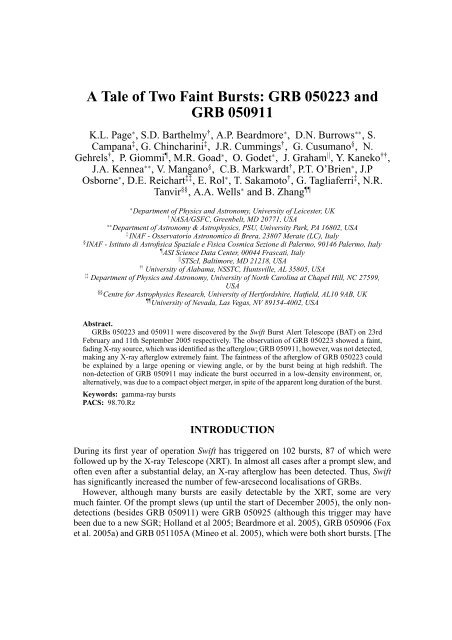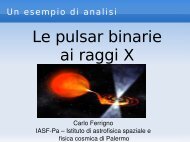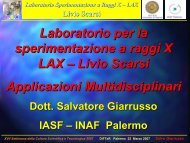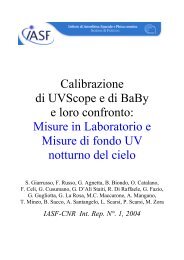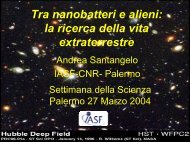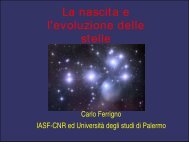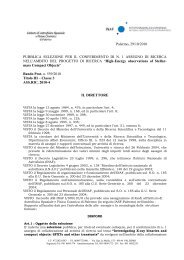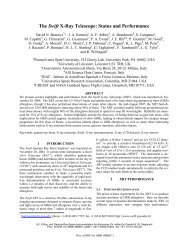GRB 050223 and GRB 050911 - IASF Palermo - Inaf
GRB 050223 and GRB 050911 - IASF Palermo - Inaf
GRB 050223 and GRB 050911 - IASF Palermo - Inaf
Create successful ePaper yourself
Turn your PDF publications into a flip-book with our unique Google optimized e-Paper software.
A Tale of Two Faint Bursts: <strong>GRB</strong> <strong>050223</strong> <strong>and</strong><br />
<strong>GRB</strong> <strong>050911</strong><br />
K.L. Page ∗ , S.D. Barthelmy † , A.P. Beardmore ∗ , D.N. Burrows ∗∗ , S.<br />
Campana ‡ , G. Chincharini ‡ , J.R. Cummings † , G. Cusumano § , N.<br />
Gehrels † , P. Giommi , M.R. Goad ∗ , O. Godet ∗ , J. Graham ‖ , Y. Kaneko †† ,<br />
J.A. Kennea ∗∗ , V. Mangano § , C.B. Markwardt † , P.T. O’Brien ∗ , J.P<br />
Osborne ∗ , D.E. Reichart ‡‡ , E. Rol ∗ , T. Sakamoto † , G. Tagliaferri ‡ , N.R.<br />
Tanvir §§ , A.A. Wells ∗ <strong>and</strong> B. Zhang <br />
∗ Department of Physics <strong>and</strong> Astronomy, University of Leicester, UK<br />
† NASA/GSFC, Greenbelt, MD 20771, USA<br />
∗∗ Department of Astronomy & Astrophysics, PSU, University Park, PA 16802, USA<br />
‡ INAF - Osservatorio Astronomico di Brera, 23807 Merate (LC), Italy<br />
§ INAF - Istituto di Astrofisica Spaziale e Fisica Cosmica Sezione di <strong>Palermo</strong>, 90146 <strong>Palermo</strong>, Italy<br />
ASI Science Data Center, 00044 Frascati, Italy<br />
‖ STScI, Baltimore, MD 21218, USA<br />
†† University of Alabama, NSSTC, Huntsville, AL 35805, USA<br />
‡‡ Department of Physics <strong>and</strong> Astronomy, University of North Carolina at Chapel Hill, NC 27599,<br />
USA<br />
§§ Centre for Astrophysics Research, University of Hertfordshire, Hatfield, AL10 9AB, UK<br />
University of Nevada, Las Vegas, NV 89154-4002, USA<br />
Abstract.<br />
<strong>GRB</strong>s <strong>050223</strong> <strong>and</strong> <strong>050911</strong> were discovered by the Swift Burst Alert Telescope (BAT) on 23rd<br />
February <strong>and</strong> 11th September 2005 respectively. The observation of <strong>GRB</strong> <strong>050223</strong> showed a faint,<br />
fading X-ray source, which was identified as the afterglow; <strong>GRB</strong> <strong>050911</strong>, however, was not detected,<br />
making any X-ray afterglow extremely faint. The faintness of the afterglow of <strong>GRB</strong> <strong>050223</strong> could<br />
be explained by a large opening or viewing angle, or by the burst being at high redshift. The<br />
non-detection of <strong>GRB</strong> <strong>050911</strong> may indicate the burst occurred in a low-density environment, or,<br />
alternatively, was due to a compact object merger, in spite of the apparent long duration of the burst.<br />
Keywords: gamma-ray bursts<br />
PACS: 98.70.Rz<br />
INTRODUCTION<br />
During its first year of operation Swift has triggered on 102 bursts, 87 of which were<br />
followed up by the X-ray Telescope (XRT). In almost all cases after a prompt slew, <strong>and</strong><br />
often even after a substantial delay, an X-ray afterglow has been detected. Thus, Swift<br />
has significantly increased the number of few-arcsecond localisations of <strong>GRB</strong>s.<br />
However, although many bursts are easily detectable by the XRT, some are very<br />
much fainter. Of the prompt slews (up until the start of December 2005), the only nondetections<br />
(besides <strong>GRB</strong> <strong>050911</strong>) were <strong>GRB</strong> 050925 (although this trigger may have<br />
been due to a new SGR; Holl<strong>and</strong> et al 2005; Beardmore et al. 2005), <strong>GRB</strong> 050906 (Fox<br />
et al. 2005a) <strong>and</strong> <strong>GRB</strong> 051105A (Mineo et al. 2005), which were both short bursts. [The
TABLE 1. γ- <strong>and</strong> X-ray parameters for <strong>GRB</strong>s <strong>050223</strong> <strong>and</strong> <strong>050911</strong>. The times<br />
over which the X-ray fluxes were calculated are given in the last row of the table.<br />
Burst <strong>GRB</strong> <strong>050223</strong> <strong>GRB</strong> <strong>050911</strong> Swift mean<br />
T 90 (s) 23 16 46<br />
15–150 keV T 90 fluence 4.8 × 10 −8 3.0 × 10 −7 2.3 × 10 −6<br />
(erg cm −2 )<br />
0.3–10 keV unabs. flux 8.2 × 10 −13 UL: 1.7 × 10 −14 5.2 × 10 −10<br />
(erg cm −2 s −1 )<br />
time range post-burst (ks) 2.8–4.0 16–716 large range<br />
afterglows of short bursts tend to be fainter <strong>and</strong> fall below the XRT detection threshold<br />
quite rapidly (e.g., Gehrels et al. 2005; Fox et al. 2005b).]<br />
We present here the analysis of two faint bursts: <strong>GRB</strong>s <strong>050223</strong> <strong>and</strong> <strong>050911</strong>. The X-<br />
ray afterglow of <strong>GRB</strong> <strong>050223</strong> was detected by the XRT after ∼ 47 minutes, whereas<br />
<strong>GRB</strong> <strong>050911</strong> remained undetected in an observation starting ∼ 4.6 hours after the burst.<br />
DATA ANALYSIS<br />
<strong>GRB</strong>s <strong>050223</strong> <strong>and</strong> <strong>050911</strong> were faint in both prompt <strong>and</strong> afterglow emission (see Table 1<br />
<strong>and</strong> Figures 1 & 2). In the case of <strong>GRB</strong> <strong>050223</strong>, the X-ray flux at 11 hours (∼ 1 × 10 −13<br />
erg cm −2 s −1 over 0.3–10 keV) was below all those detected by BeppoSAX (Piro 2004).<br />
The flux upper limit of 1.7 × 10 −14 erg cm −2 s −1 for <strong>GRB</strong> <strong>050911</strong> shows that, at<br />
∼ 10 4 s, any X-ray afterglow emission was at least an order of magnitude fainter than all<br />
of the other long bursts detected by Swift, with the possible exception of <strong>GRB</strong> 050421<br />
(Figure 1; Godet et al. 2005; Nousek et al. 2005).<br />
<strong>GRB</strong> <strong>050223</strong> - a large opening/viewing angle or high redshift?<br />
Using the st<strong>and</strong>ard <strong>GRB</strong> afterglow models (Zhang & Mészáros 2004), the data for this<br />
burst are inconsistent with post-jet-break evolution. A large opening angle could explain<br />
both a late jet-break <strong>and</strong> the faintness of the afterglow, as well as the BAT fluence being<br />
relatively low. Alternatively, the low afterglow flux <strong>and</strong> prompt fluence could be caused<br />
by the burst being at high redshift; Swift <strong>GRB</strong>s are at a mean redshift of ∼ 2.1, while<br />
pre-Swift, the mean was ∼ 1.2. More details on the analysis of <strong>GRB</strong> <strong>050223</strong> can be<br />
found in Page et al. (2005a).<br />
<strong>GRB</strong> <strong>050911</strong> - a naked <strong>GRB</strong> or a short burst?<br />
The complete non-detection of an X-ray afterglow is very unusual for Swift bursts,<br />
as mentioned above. Any afterglow corresponding to the burst <strong>GRB</strong> <strong>050911</strong> must have<br />
faded very rapidly or been extremely faint to be undetected at ∼ 4.6 hours. One possible
FIGURE 1. Flux light-curves for a selection of Swift <strong>GRB</strong>s, showing the faintness of the X-ray afterglows<br />
of <strong>GRB</strong> <strong>050223</strong> (thick red line) <strong>and</strong> <strong>GRB</strong> <strong>050911</strong> (blue 3σ upper limit). Adapted from Nousek et<br />
al. (2005).<br />
FIGURE 2.<br />
of the bursts.<br />
BAT light-curves (1-s bins) showing the count-rate per fully illuminated detector for each<br />
explanation is the ‘naked <strong>GRB</strong>’ model, whereby the burst occurs in a low density<br />
environment, with the lack of surrounding material leading to a weak, or non-existent,<br />
forward shock. This may be the cause of the faintness of <strong>GRB</strong> 050421 (Godet et al.<br />
2005).<br />
Short bursts (T 90 < 2 s; thought to be formed through compact object mergers) tend to<br />
show weak afterglows, fading below the XRT detection threshold within a few thous<strong>and</strong>
seconds. Although T 90 > 2 s for <strong>GRB</strong> <strong>050911</strong>, there are two initial short (∼ 0.5 s) spikes.<br />
Thus, <strong>GRB</strong> <strong>050911</strong> is like many short bursts in showing an initial short peak followed<br />
by longer, softer faint high energy emission (Lazzati, Ramirez-Ruiz & Ghisellini 2001;<br />
Connaughton 2002; Norris & Bonnell 2005). Simulations show that the later peak would<br />
not have been detected by BATSE at greater than the 1σ level; therefore, if BATSE had<br />
triggered on this weak burst at all, it is likely that it would have been classed as short.<br />
<strong>GRB</strong> <strong>050911</strong> could, therefore, have been caused by a merger event: if one of the<br />
compact objects were a black hole, rather than a neutron star, the large mass ratio could<br />
lead to delayed accretion <strong>and</strong>, hence, high energy emission after 2 s (Davies, Levan &<br />
King 2005). See Page et al. (2005b) for more details.<br />
CONCLUSIONS<br />
The X-ray afterglows of both <strong>GRB</strong> <strong>050223</strong> <strong>and</strong> <strong>GRB</strong> <strong>050911</strong> are among the faintest<br />
observed at early times. Although Swift has the ability to measure faint X-ray emission<br />
out to many days after the burst, some afterglows are still too weak to be detected,<br />
indicating a difference in environment <strong>and</strong>/or formation mechanism.<br />
REFERENCES<br />
1. S. Barthelmy et al., 2005, Nature Letters, in press<br />
2. A.P. Beardmore, K.L. Page., N. Gehrels, J. Greiner, J. Kennea, J. Nousek, J.P. Osborne,<br />
G. Tagliaferri, 2005, GCN4043<br />
3. V. Connaughton, 2002, ApJ, 567, 1028<br />
4. M.B. Davies, A.J. Levan & A.R. King, 2005, MNRAS, 356, 54<br />
5. D.B. Fox, C. Pagani, L. Angelini, D.N. Burrows, J.P. Osborne & V. La Parola, 2005a,<br />
GCN 3956<br />
6. D.B. Fox et al., 2005b, in prep.<br />
7. N. Gehrels et al., 2005, ApJ, 611, 1005<br />
8. O. Godet et al., 2005, A&A, in press<br />
9. S.T. Holl<strong>and</strong> et al., 2005, GCN 4034<br />
10. D. Lazzati, E. Ramirez-Ruiz, G. Ghisellini, 2001, A&A, 379, L39<br />
11. T. Mineo et al., 2005, GCN4188<br />
12. J.P. Norris & J.T. Bonnell, 2005, ApJ, submitted<br />
13. J.A. Nousek at al., 2005, ApJ, submitted (astro-ph/0508332)<br />
14. C. Pagani, V. La Parola, & D.N. Burrows, 2005, GCN3934<br />
15. K.L. Page et al., 2005a, MNRAS, 363, L76<br />
16. K.L. Page et al., 2005b, ApJL, in press (astro-ph/0512358)<br />
17. L. Piro, 2004, ASP Conference Series, Vol. 312, in press (astro-ph/0402638)<br />
18. B. Zhang & P. Mészáros, 2004, Int.J.Mod.Phys, 19, 2385


